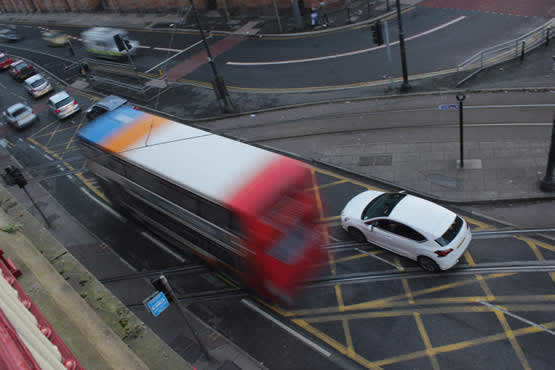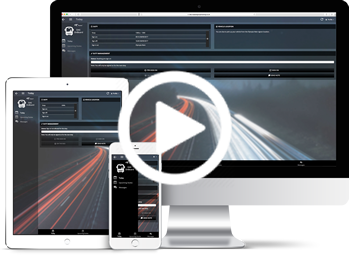Are we Seeing the End of Fixed Route Scheduling?
Mining data, dynamic scheduling – and the emergence of Flex services
Fixed
adjective
Fastened, attached, or placed so as to be firm and not readily movable; firmly implanted; stationary; rigid.
Most dictionary definitions of the term fixed invoke concepts of immovability and constancy. When considering bus services, this suggests some positives – most obviously, stability and reliability. But of course there is a negative interpretation too: after all, fixed also means rigidity and inflexibility.
The fixed route inflexibility issue
In terms of bus services, fixed routes involve predefined schedules designed to satisfy perceived need, with timetables produced according to predicted fixed travel times between stops. While timetables will naturally vary through the course of a day or week – more buses tend to be required on a Monday morning than a Sunday afternoon – broadly speaking, there tends to be little variation in the expected journey time, and no attempt to integrate real-time information with scheduling and timetabling.
Staff producing fixed route schedules tend to believe that over time they have refined the schedules in order to identify the most efficient and cost-effective solution. However, because they are unable to respond in real time to fluctuations in demand – or even accurately assess their current performance – this fixed approach is, in many ways, fundamentally inflexible.
Of course we also have Demand Responsive Transport (DRT) services, which can be laid on at a moment’s notice (perhaps to replace a disrupted rail service), or booked ahead, though still on an ad-hoc basis (perhaps to shuttle visitors to and from a one-off event). However, while DRT services are more responsive than fixed route operations, they are limited in that each vehicle generally operates as a standalone service. That is, each time a new DRT service is deployed, it rarely learns from the performance of previous, similar services; cannot adapt to one-off circumstances happening now; and simply focuses on filling the service gap as quickly as possible. Therefore, DRT services are also inflexible – just in different ways – and cannot be the answer to the inflexibility issue.
Fixed routes; fixed limitations
Before exploring the alternatives, let’s delve a little deeper into the potential challenges associated with fixed route bus services. Here there are two main issues to consider:
Lack of responsiveness
Fixed route services are, by definition, fixed. Because timetabling processes tend to follow a linear structure of planning, testing and implementation, they can be inflexible when it comes to responding to how things actually work in practice. If a timetable turns out to be inaccurate, with a significant proportion of services running faster or slower than intended, it typically takes a long time for this to be identified and the timetable rectified (if ever). Meanwhile, when short-term or one-off disruptions (such as roadworks) wreak havoc on a timetable one day, the service as a whole typically has few to no resources in place to anticipate the impact this will have on later services – and therefore adjust those services. In turn, this means that the same event is likely to continue impacting the same bus timetable, over and over again.
Poor performance
This lack of responsiveness, in conjunction with fixed services generally assuming that a timed journey will always take the same time, mean that such services tend to perform sub-optimally in practice. A service may consistently run late during rush hour, for example – precisely when it comes under heavy demand. Conversely, it could consistently run early at quieter times, and therefore have to wait at stops to regulate service. Both factors lead to poor schedule adherence and inefficient services, and reduce passenger satisfaction which then impacts ridership levels. In short: poor performance increases cost and damages revenue – a fatal combination for any operator.
Merging modes: the rise of Flex services
Given these limitations, is it time to move towards a future of intelligent, highly aware and responsive mobility solutions?
We are seeing increasing interest in the concept of ‘Flex’ services, where buses follow somewhat fixed routes, with the ability to deviate in order to meet demand. This type of service can take on varying forms, though an obvious use case involves routes that are somewhat fixed in urban areas, transitioning to something much close to a demand-based model when moving into rural areas.
A Flex model offers great potential for offering mobility services more closely aligned with passenger demands. However, it requires the right approach and supporting technology.
But perhaps most critically, this mode depends on the availability of data that enables operators to develop a dynamic approach to service scheduling
Driven by data: The dynamic revolution
Organisations such as Google and Facebook have become global powerhouses by recognising that in the modern world data is one of the most precious and valuable commodities. It is therefore surprising that in our industry public transport data is all too often overlooked.
Could it be that the solution to the problems outlined above is already sitting, untapped, within our transport management systems? By capturing, analysing and understanding data – and ultimately by adapting based upon what we learn from it – bus operators can radically improve their operating performance.
Let’s start by looking at some obvious data sources:
- Bus location: Holistic visibility of the location of the entire fleet helps managers to regulate service, spacing out vehicles appropriately and minimising passenger waiting times.
- Bus speed: Oversight regarding which parts of the route are faster or slower, and how speeds change through the day and week.
- Live traffic updates: Intelligent route planning based on live traffic updates can help drivers and managers to anticipate disruption and adjust routes accordingly.
- Vehicle performance: Mechanical problems causing cancellations immediately impact later services within a timetable, and require replacement vehicles and staff alterations.
- Planned disruptions: From road works to one-off events, there is a wealth of information available to service planners from external sources such as utilities companies and local councils.
Of course, most large operators already have GPS tracking technology fitted within all buses. Such technology should be mined for data, and the information consolidated to create an accurate picture of what actually happens on a given route or timetable. This is critical feedback because it will enable operators to stop guessing and start making use of data-driven real-time predictions.
Wanted: one dynamic algorithm
The key to this development is the availability of a truly next-generation scheduling algorithm – one that is able to come up with an optimal set of timetables, running boards and duties to fulfil the operations for the day, taking account of dynamic variations in link and dwell times. This type of technology could also produce a shorter-range forecast of travel times based on current link times to deal with disruption.
Such an algorithm would deliver two key benefits:
1. Planning feedback loop
Data can be fed back in to the initial timetable planning and development process, evolving from a linear to a feedback loop structure. The schedule information available is then both more accurate and more adaptable, taking into account changing factors over the course of days and weeks. The result is more robust and accurate schedules, with an intelligent understanding of how journey times vary – and how those variables should be built into the timetable. In turn, the entire timetable performs better.
2. Real-time responsiveness
The data can also be used in real-time, enabling managers, dispatchers and drivers to respond rapidly and intelligently to changes in traffic, road conditions, cancellations, diversions and even engine problems with individual vehicles. In turn, this allows services – and staff resource – to be optimised across the entire fleet, and improves both staff and passenger satisfaction.
Redefining fixed route transport
In the coming years we will see effective mining and use of data enabling service providers to move away from what we currently know of as fixed route transport by blending the best elements of fixed and ‘on demand’ services.
Current providers of fixed route services will still be able to provide passengers (and staff) with a pre-prepared timetable – but it will be far more accurate and proactively adjusted across days and weeks in order to account for predictable, yet fluctuating journey times.
By using technology to effectively process the data available, transport organisations have the capability to move towards ‘Flex’ models, where existing fixed route services become more responsive to varying incidents and levels of demand.
With a dynamic scheduling algorithm powering the back end, and incident-aware live running boards at the passenger end, we can look forward to a truly dynamic transport offering – for both passengers and transport providers.
From theory to reality
Fixed route timetables and schedules can often fail to reflect real world services because they cannot take account of the disruptions, delays and multitude of variations that are part of everyday life. They work in theory but not practice. This leads to passenger frustration, dissatisfaction and even service abandonment – as well as inefficiencies for operators.
Intelligent data mining to fuel dynamic scheduling is a truly transformative proposition. It offers an immediate impact on costs and ridership, promising to reduce inefficient journeys and increase passenger satisfaction at a stroke.
But its greatest positive impact is likely to be felt far beyond the short-term, through the development of far more flexible, adaptive and context-specific services. The dream of a truly dynamic transport offering is on its way – and it is set to transform the industry.

Here to help
Contact us and speak with one of our specialists:
+44 (0) 808 281 1039
More Info
About Us | Careers | Contact Us | Legal | Privacy
(c) 1999 – 2019 Trapeze Software ULC. All rights reserved
Trapeze Group respects your privacy

